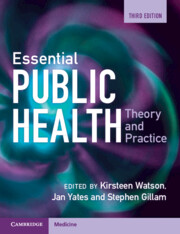Book contents
- Essential Public Health
- Essential Public Health
- Copyright page
- Contents
- Contributors
- Foreword
- Acknowledgements
- Introduction
- Part 1 The Public Health Toolkit
- 1 Health Needs Assessment
- 2 Health Information
- 3 Epidemiology
- 4 Evidence-Based Health-Care
- 5 Decision-Making and Priority Setting
- 6 Improving Quality of Care
- 7 Management, Leadership and Change
- 8 Improving Population Health
- 9 Screening
- 10 Health Protection and Communicable Disease Control
- Part 2 Contexts for Public Health Practice
- Glossary
- Index
- References
10 - Health Protection and Communicable Disease Control
from Part 1 - The Public Health Toolkit
Published online by Cambridge University Press: 01 December 2023
- Essential Public Health
- Essential Public Health
- Copyright page
- Contents
- Contributors
- Foreword
- Acknowledgements
- Introduction
- Part 1 The Public Health Toolkit
- 1 Health Needs Assessment
- 2 Health Information
- 3 Epidemiology
- 4 Evidence-Based Health-Care
- 5 Decision-Making and Priority Setting
- 6 Improving Quality of Care
- 7 Management, Leadership and Change
- 8 Improving Population Health
- 9 Screening
- 10 Health Protection and Communicable Disease Control
- Part 2 Contexts for Public Health Practice
- Glossary
- Index
- References
Summary
Health protection refers to threats to health such as infectious diseases, environmental threats, natural hazards and threats from terrorist acts. Health protection may also overlap with action, tackling the determinants of health, especially legislative aspects such as workplace smoking bans or speed restrictions and even lifestyle choices and the health issues of ageing populations, such as increasing levels of chronic disease (which we now know may also be due to infections).
This chapter outlines the public health aspects of communicable disease control and touches on some of the other areas now included within health protection in the UK. Important health protection terms are included in the glossary.
Keywords
- Type
- Chapter
- Information
- Essential Public HealthTheory and Practice, pp. 183 - 202Publisher: Cambridge University PressPrint publication year: 2023



